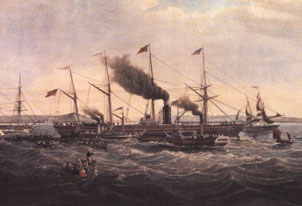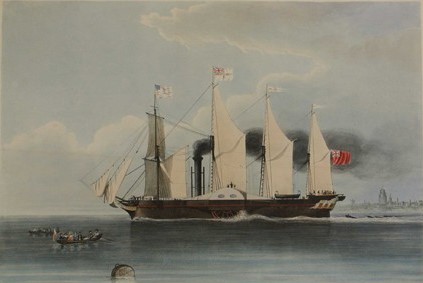|
William Patterson (engineer)
William Patterson (1795–1869) was a Scottish engineer and boatbuilder. Born in Arbroath, he moved to London where he learned his craft at the yard of William Evans. He then moved to Bristol where he worked for William Scott as his assistant. When Scott became bankrupt, he took over his yard in various guises as William Patterson Shipbuilders. He won the contract to design and build the SS ''Great Western'' with Isambard Kingdom Brunel Isambard Kingdom Brunel (; 9 April 1806 – 15 September 1859) was a British civil engineer who is considered "one of the most ingenious and prolific figures in engineering history," "one of the 19th-century engineering giants," and "on .... He was also one of the designers of the SS ''Great Britain'' (again with Brunel), the world's first ocean-going ship to have an iron hull and a screw propeller. He was born in 1795, married to Eliza Manning in 1825, had eleven children, and died in 1869 in Liverpool. He is buried in an un ... [...More Info...] [...Related Items...] OR: [Wikipedia] [Google] [Baidu] |
Arbroath
Arbroath () or Aberbrothock ( gd, Obar Bhrothaig ) is a former royal burgh and the largest town in the council area of Angus, Scotland, with a population of 23,902. It lies on the North Sea coast some ENE of Dundee and SSW of Aberdeen. There is evidence of Iron Age settlement, but its history as a town began with the founding of Arbroath Abbey in 1178. It grew much during the Industrial Revolution through the flax and then the jute industry and the engineering sector. A new harbour created in 1839; by the 20th century, Arbroath was one of Scotland's larger fishing ports. It is notable for the Declaration of Arbroath and the Arbroath smokie. Arbroath Football Club holds the world record for the number of goals scored in a professional football match: 36–0 against Bon Accord of Aberdeen in the Scottish Cup in 1885 History Toponymy The earliest recorded name was 'Aberbrothock', referring to the Brothock Burn that runs through the town. The prefix ''Aber'' derived ei ... [...More Info...] [...Related Items...] OR: [Wikipedia] [Google] [Baidu] |
William Scott Shipbuilders
William Scott Shipbuilders was a short-lived shipbuilder in Bristol, England in the 19th century and an early producer of steamships. The yard was important in the development of Bristol Shipbuilding. Scott's assistant, William Patterson, went on to build . History Origins & Shipowning The founder, William Scott (b. 1756), was part of a well known Scottish shipbuilding family from Greenock, and moved to Barnstaple, England, in the late-18th century to engage in the timber trade. With Christopher Scott (probably his brother) he purchased his first vessel in around 1810, the barque ''William'' for the New Brunswick to Baltic route. They later acquired a number of vessels including the sloop ''Pomona'' of 32 t, which they used as a packet on the Greenock-Bristol run. Shipbuilding Hilhouse vacated the shipyard and dry-dock at Wapping on the south side of the River Avon in 1824, and Scott seized the opportunity to enter shipbuilding with his son, James Mullen Scott, as Wi ... [...More Info...] [...Related Items...] OR: [Wikipedia] [Google] [Baidu] |
William Patterson Shipbuilders
William Patterson Shipbuilders was a major shipbuilder in Bristol, England during the 19th century and an innovator in ship construction, producing both the ''SS Great Western'' and ''SS Great Britain'', fine lined yachts and a small number of warships.Farr, Graeme (1977). ''Shipbuilding in the Port of Bristol'' National Maritime Museum Maritime Monographs and Reports. p8 History Origins William Patterson (engineer), Patterson, the founder, was born in Arbroath, Scotland, in 1795 and worked his way up from London shop seller to shipwright at Rotherhithe, and then foreman at steamship builder William Evans. Here he took charge of the yard for the build of the steam packet ''Dasher'' for the Post Office, before moving to Bristol in 1823 to become assistant to William Scott Shipbuilders, William Scott at his ship at Wapping. When Scott when bankrupt in 1830, Patterson stepped in to take over the yard at East Wapping with partner John Mercer, Jr, as Patterson & Mercer. He also had ... [...More Info...] [...Related Items...] OR: [Wikipedia] [Google] [Baidu] |
SS Great Western
SS ''Great Western'' of 1838, was a wooden-hulled paddle-wheel steamship with sails the first steamship purpose-built for crossing the Atlantic, and the initial unit of the Great Western Steamship Company. She was the largest passenger ship in the world from 1837 to 1839, which was then passed by the . Designed by British civil engineer Isambard Kingdom Brunel, ''Great Western'' proved satisfactory in service and was the model for all successful wooden Atlantic paddle-steamers. She was capable of making record Blue Riband voyages as late as 1843. ''Great Western'' worked to New York for 8 years until her owners went out of business. She was sold to the Royal Mail Steam Packet Company and was scrapped in 1856 after serving as a troop ship during the Crimean War. Development and design In 1836, Isambard Brunel, his friend Thomas Guppy and a group of Bristol investors formed the Great Western Steamship Company to build a line of steamships for the Bristol-New York route. The ide ... [...More Info...] [...Related Items...] OR: [Wikipedia] [Google] [Baidu] |
Isambard Kingdom Brunel
Isambard Kingdom Brunel (; 9 April 1806 – 15 September 1859) was a British civil engineer who is considered "one of the most ingenious and prolific figures in engineering history," "one of the 19th-century engineering giants," and "one of the greatest figures of the Industrial Revolution, hochanged the face of the English landscape with his groundbreaking designs and ingenious constructions." Brunel built dockyards, the Great Western Railway (GWR), a series of steamships including the first propeller-driven transatlantic steamship, and numerous important bridges and tunnels. His designs revolutionised public transport and modern engineering. Though Brunel's projects were not always successful, they often contained innovative solutions to long-standing engineering problems. During his career, Brunel achieved many engineering firsts, including assisting in the building of the first tunnel under a navigable river (the River Thames) and the development of the , the first ... [...More Info...] [...Related Items...] OR: [Wikipedia] [Google] [Baidu] |
SS Great Britain
SS ''Great Britain'' is a museum ship and former passenger steamship that was advanced for her time. She was the largest passenger ship in the world from 1845 to 1854. She was designed by Isambard Kingdom Brunel (1806–1859), for the Great Western Steamship Company's transatlantic service between Bristol and New York City. While other ships had been built of iron or equipped with a screw propeller, ''Great Britain'' was the first to combine these features in a large ocean-going ship. She was the first iron steamer to cross the Atlantic Ocean, which she did in 1845, in 14 days. The ship is in length and has a 3,400-ton displacement. She was powered by two inclined two-cylinder engines of the direct-acting type, with twin high pressure cylinders (diameter uncertain) and twin low pressure cylinders bore, all of stroke cylinders. She was also provided with secondary masts for sail power. The four decks provided accommodation for a crew of 120, plus 360 passengers who were ... [...More Info...] [...Related Items...] OR: [Wikipedia] [Google] [Baidu] |
Scottish Engineers
Scottish usually refers to something of, from, or related to Scotland, including: *Scottish Gaelic, a Celtic Goidelic language of the Indo-European language family native to Scotland *Scottish English *Scottish national identity, the Scottish identity and common culture *Scottish people, a nation and ethnic group native to Scotland *Scots language, a West Germanic language spoken in lowland Scotland *Symphony No. 3 (Mendelssohn), a symphony by Felix Mendelssohn known as ''the Scottish'' See also *Scotch (other) *Scotland (other) *Scots (other) *Scottian (other) *Schottische The schottische is a partnered country dance that apparently originated in Bohemia. It was popular in Victorian era ballrooms as a part of the Bohemian folk-dance craze and left its traces in folk music of countries such as Argentina ("chotis"Span ... * {{disambiguation Language and nationality disambiguation pages ca:Escocès ... [...More Info...] [...Related Items...] OR: [Wikipedia] [Google] [Baidu] |
People From Arbroath
A person ( : people) is a being that has certain capacities or attributes such as reason, morality, consciousness or self-consciousness, and being a part of a culturally established form of social relations such as kinship, ownership of property, or legal responsibility. The defining features of personhood and, consequently, what makes a person count as a person, differ widely among cultures and contexts. In addition to the question of personhood, of what makes a being count as a person to begin with, there are further questions about personal identity and self: both about what makes any particular person that particular person instead of another, and about what makes a person at one time the same person as they were or will be at another time despite any intervening changes. The plural form "people" is often used to refer to an entire nation or ethnic group (as in "a people"), and this was the original meaning of the word; it subsequently acquired its use as a plural form of per ... [...More Info...] [...Related Items...] OR: [Wikipedia] [Google] [Baidu] |
1795 Births
Events January–June * January – Central England records its coldest ever month, in the CET records dating back to 1659. * January 14 – The University of North Carolina opens to students at Chapel Hill, becoming the first state university in the United States. * January 16 – War of the First Coalition: Flanders campaign: The French occupy Utrecht, Netherlands. * January 18 – Batavian Revolution in Amsterdam: William V, Prince of Orange, Stadtholder of the Dutch Republic (Republic of the Seven United Netherlands), flees the country. * January 19 – The Batavian Republic is proclaimed in Amsterdam, ending the Dutch Republic (Republic of the Seven United Netherlands). * January 20 – French troops enter Amsterdam. * January 23 – Flanders campaign: Capture of the Dutch fleet at Den Helder: The Dutch fleet, frozen in Zuiderzee, is captured by the French 8th Hussars. * February 7 – The Eleventh Amendment to the United ... [...More Info...] [...Related Items...] OR: [Wikipedia] [Google] [Baidu] |





_1938.jpg)
